Upon the recent appointment of Julien Stéphan for his second stint as Rennes boss, the club’s technical director Florian Maurice, whose project with the Brittany-based side we recently analysed in detail here at Total Football Analysis, openly admitted to RMC Sport that a Rennes return for Stéphan was not his “first choice”, indicating that the club’s move for the 43-year-old was born more out of a need to just get somebody into the position following Bruno Génésio’s abrupt departure.
Several managers spring to mind who could’ve been preferred options for Les Rouge et Noirs, including the likes of Will Still of Reims, who could see a move to Rennes as a step up in terms of prestige, although with that said, it might have been impossible to take the promising young coach away from his Reims project at present in favour of a floundering Rennes.
Rennes’ squad value as of 11th September, per CIES Football Observatory, was €209m — the third-highest in Ligue 1 behind only PSG and Monaco. However, they currently sit a lowly 13th on the table, having won just two of their first 12 games this term. It would be an understatement to say they’ve failed to live up to expectations and deliver according to the quality of their squad.
Still, taking over a squad with such quality and getting them back on track would be an attractive prospect for many coaches in Europe’s top-five leagues (or ‘Tier 1’ clubs, according to our tier list) as well as the vast majority of coaches currently working at ‘Tier 2’ clubs (our ‘Tier 2’ leagues are as follows: EFL Championship, Russian Premier League, Liga Portugal, Turkish Süper Lig, Argentine Primera División, Campeonato Brasileiro Série A, Belgian Pro League and Dutch Eredivisie).
This tactical analysis and head coach-focused scout report will highlight three top managers currently working in one of those leagues who may be of interest to the next ‘Rennes-level’ club in need of a new head coach. Each of these coaches has demonstrated excellent ability in their current role, which may warrant the attention of clubs that could offer them even greater resources to compete at the highest possible level.
We’ll provide some analysis of each manager’s tactics in and out of possession with their respective clubs at the moment to highlight how they’ve got their teams performing at such a high standard.
Javier Gandolfi, 42 years old, CA Talleres
First up for us is 42-year-old Javier Gandolfi from Argentina’s CA Talleres. Gandolfi guided his side to a second-place finish in the Argentinian league this season before having a slightly less impressive run in the Copa de la Liga Profesional campaign that directly followed in the second half of their season. Overall, however, Talleres certainly put together some impressive performances this year, and Gandolfi’s job was largely positive.
Gandolfi’s Talleres side primarily stood out from an attacking standpoint this year, scoring the second-most goals (54) and accumulating the third-highest xG (54.5) of any team over the two separate phases of the Argentinian season.
Talleres also attempted the third-most shots per 90 (11.64) and tallied up the third-most touches inside the opposition’s penalty area (15.33), two further vital indicators of their success in getting forward and putting the ball in good goalscoring positions on a regular basis.
Gandolfi has primarily lined his team up in a 4-2-3-1 shape this season; they tend to try and play out from the back through the backline who will look to quickly get play moving upfield with progressive passes towards the attacking midfielders, wingers and centre-forward.
Talleres require aggressiveness, risk-taking and a penetrative nature from those deep-lying players in the build-up and ball progression phases.
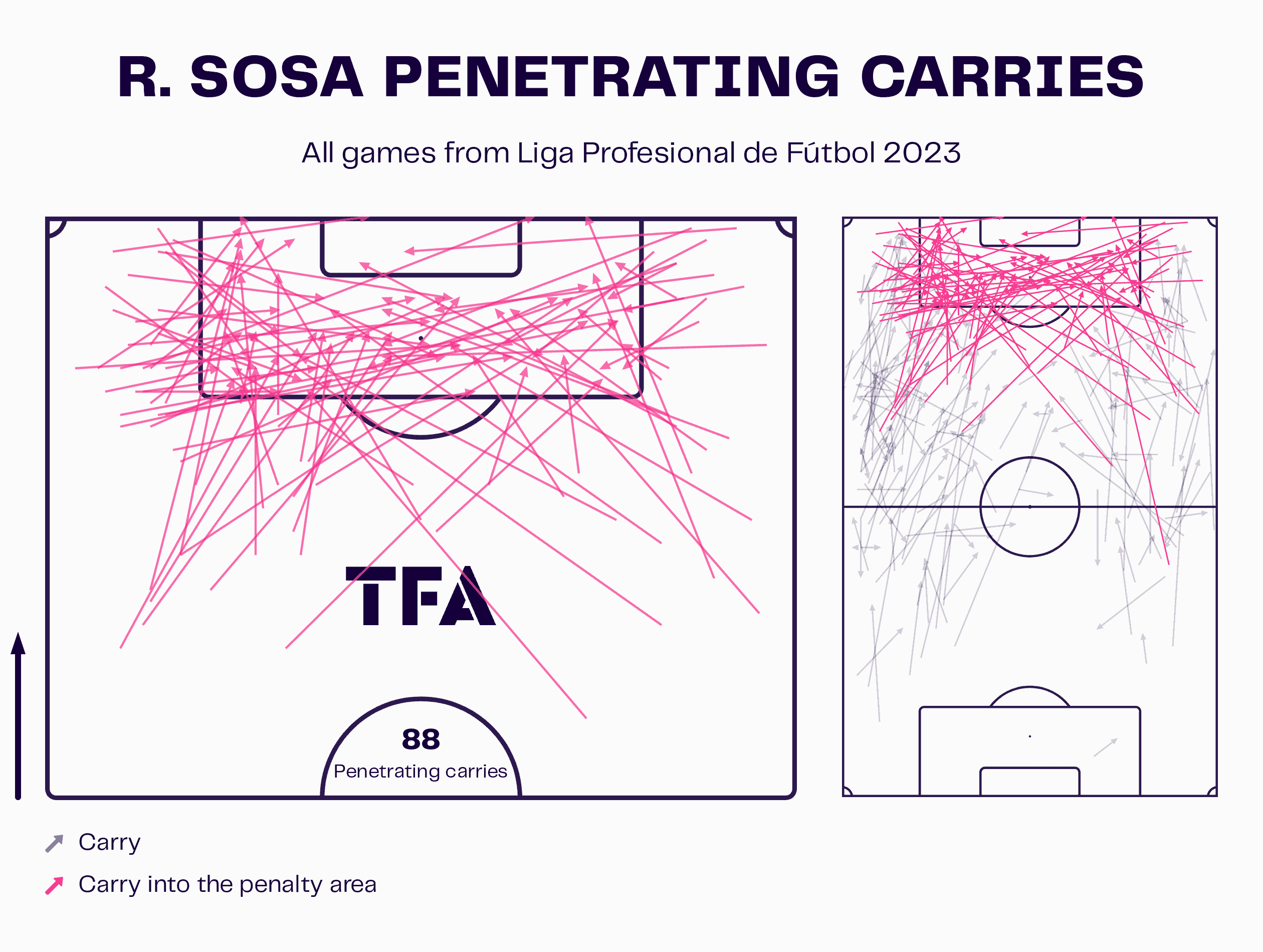
Once in the final third, the playmakers must continue displaying the bravery and technical quality that has helped Talleres generate many goalscoring opportunities this term. A couple of key players have helped significantly with this, the first of whom is 24-year-old Ramón Sosa, a crucial creator and goalscorer for his team in 2023. Fearless ball-carrying has been a notable aspect of his game during the current campaign — we’ve displayed his penetrating carries map from 2023 in figure 1.
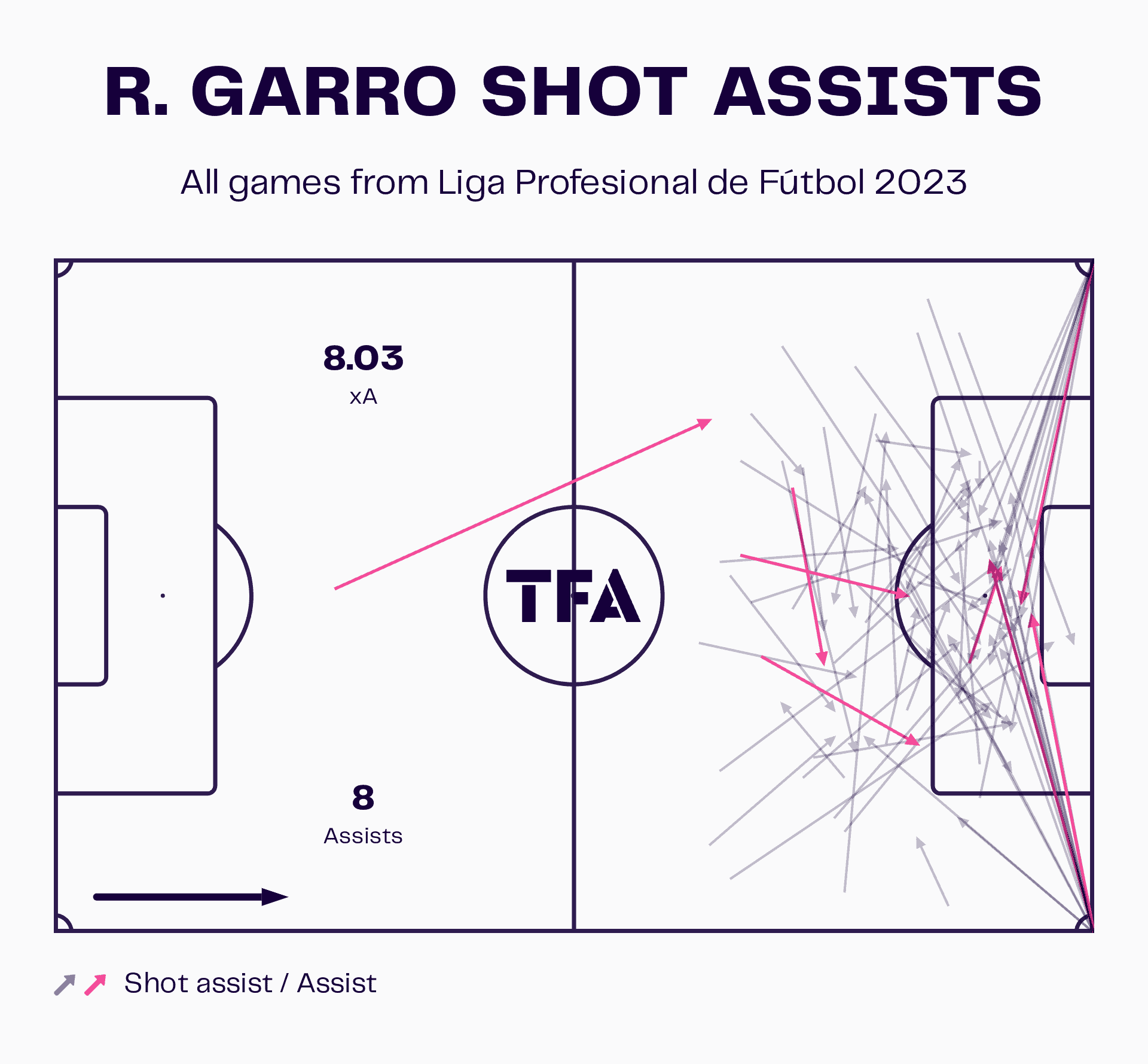
Then, 25-year-old Rodrigo Garro has also been a vital creator for his side from slightly more central areas than Sosa, but one who’s been given the freedom to drift around the pitch from a ‘10’ position, frequently turning up out wide or in the half-spaces. Garro’s set-piece-taking ability has also been vital to his side’s goalscoring in 2023/24.
Expect to see some positional rotations among the attacking midfielders in this team as playmakers seek space from which they can create effectively, springing attackers away into good goalscoring positions. Gandolfi has done well to craft an environment that puts these creative players in good positions to display the best of their abilities.
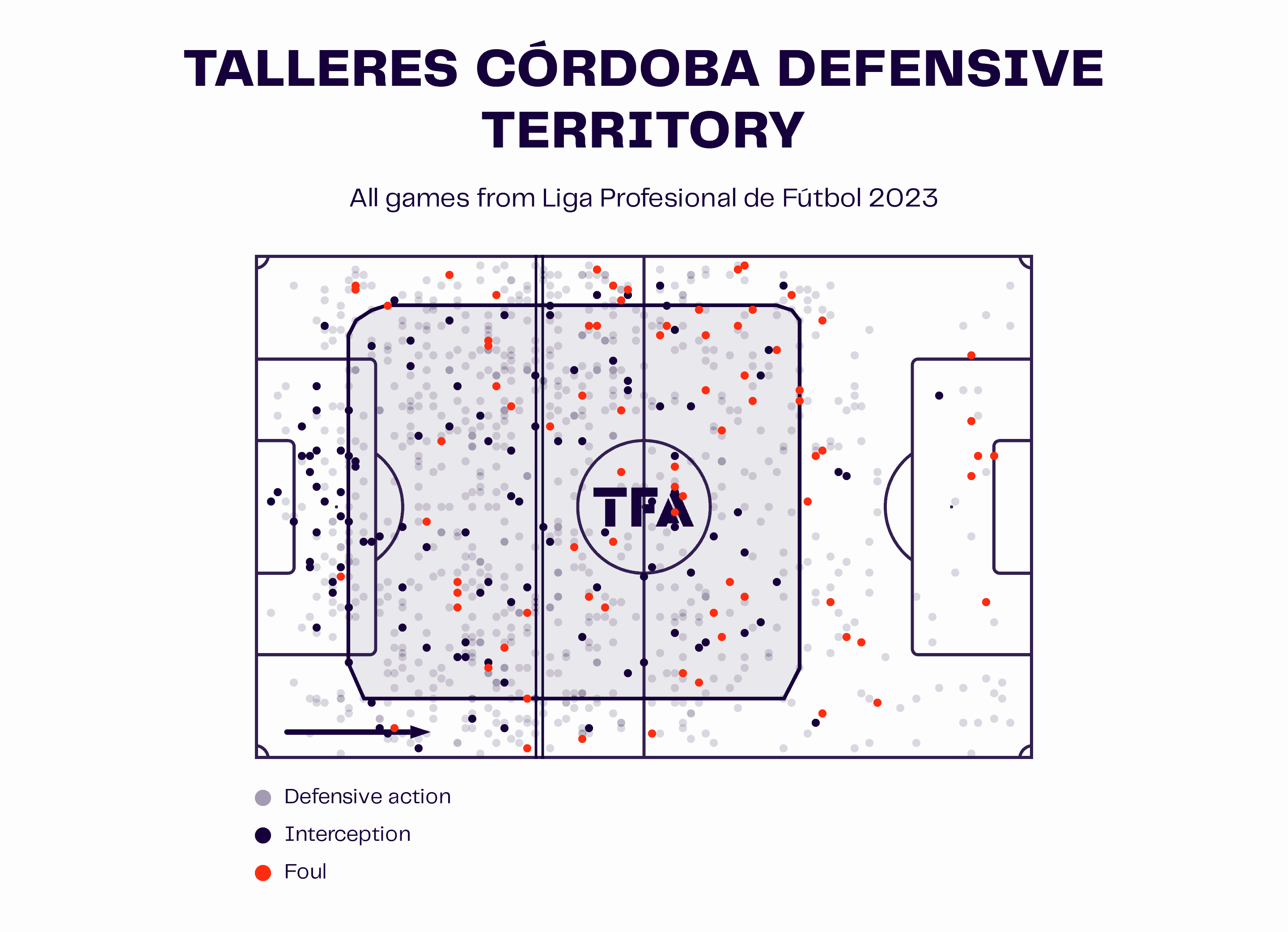
Here’s Talleres’ defensive territory map from the 2023 campaign, highlighting their average area of engagement and the average height of their defensive line. They haven’t been the most aggressive team in Argentina’s top flight by any means but have still defended in a reasonably aggressive manner with a relatively high line.
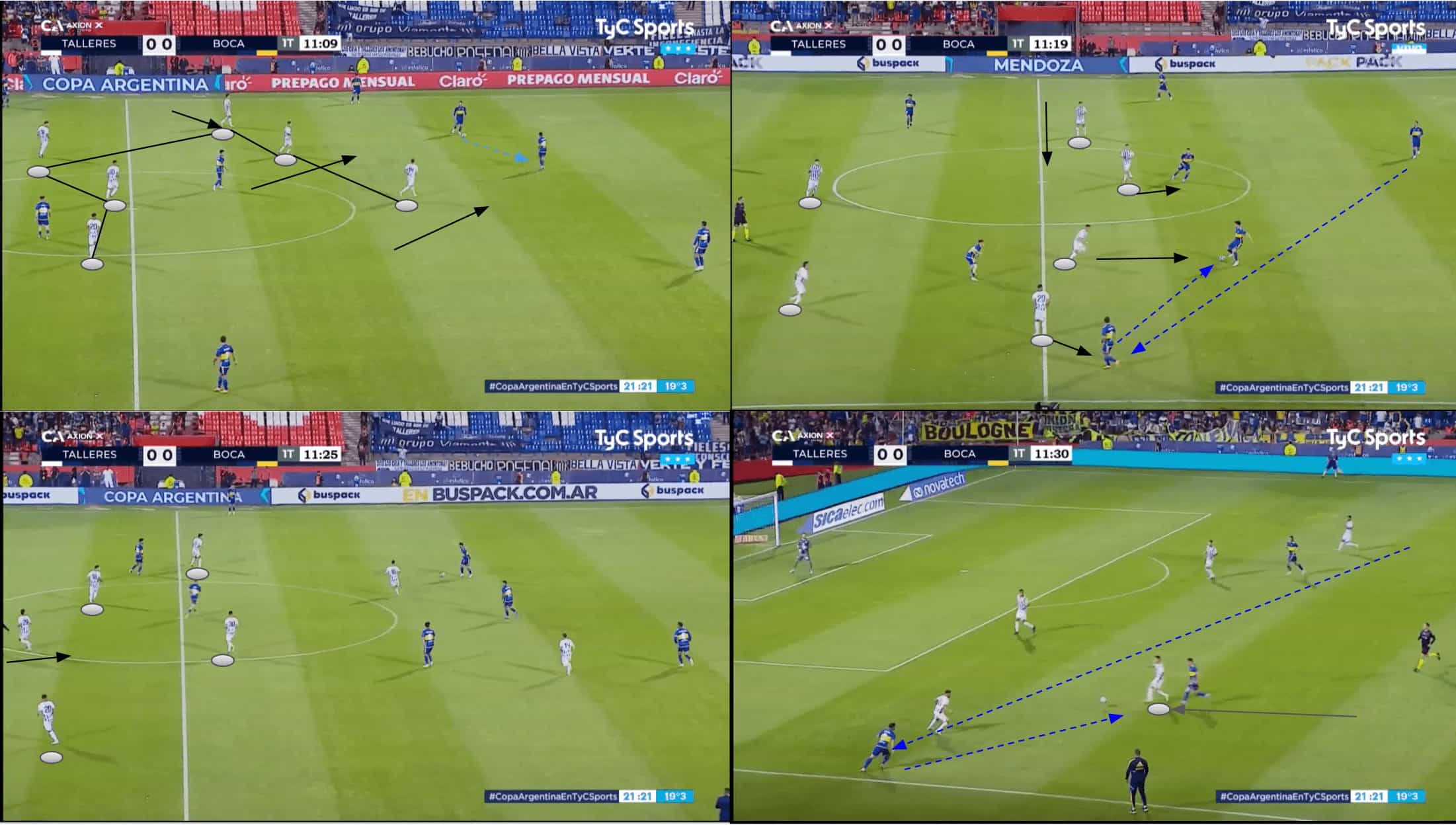
Figure 4 displays an example of their mid-block setup against Boca Juniors. Here, in the top-left image, we can see how Talleres’ defensive block has got very compact and huddled together while targeting the space around the opposition ball carrier on this side of the pitch.
The opposition centre-back comes under some pressure from Talleres’ pressing forwards while the space all around him has been congested by Talleres bodies, making a simple pass forward difficult to achieve.
With this space-oriented system, Gandolfi’s men leave some space open far from the ball, which Boca can play to via the switch, but Talleres are organised and quickly shut down the space on that side of the pitch, too. The central midfielders will push forward to cover specific opposition players in a man-to-man fashion in this system, while centre-backs push forward to cover any space that then opens up behind them in midfield.
The idea with this pressing system is to make safer passes impossible to pull off, forcing the opponent into longer, riskier passes. In the end, we see the ball is played long over the top from Boca as they target space in the backline that’s opened up due to the centre-back stepping forward to cover for the aggressive midfielder. This ball finds a Boca player, but his pass is then intercepted by a Talleres midfielder tracking back to support the last defensive line and ensure the opponent does not create a dangerous chance.
This is one example of the defensive organisation and discipline Gandolfi has successfully implemented to some extent with Talleres, though, again, it must be said that his side has primarily stood out much more from an offensive standpoint than a defensive one — something any future club will be keen to note when looking at the type of manager they want and the brand of football they want to play.
António Oliveira, 41 years old, Cuiaba
From Argentina, we’ll now shift across to their historic South American rivals Brazil. In Campeonato Brasileiro Série A, Cuiabá have significantly outperformed expectations this season; boasting the least-valuable squad in Brazil’s top-flight, per Transfermarkt, they currently sit ninth in the league table with just a few games yet to be played — well clear of the relegation zone.
Cuiabá’s out-of-possession play has stood head and shoulders above their possession play this term, in contrast to Gandolfi’s Talleres. It must be stressed that there’s a clear difference in the relative level of quality between the two teams, with Talleres far better prepared to compete in their division than Cuiabá in theirs.
Oliveira’s team have conceded the sixth-fewest goals (35) in Brazil’s Série A this term, along with having conceded the fourth-lowest xGA (40.95) in the league, highlighting the effectiveness of the defensive tactics and strategies that they’ve employed.
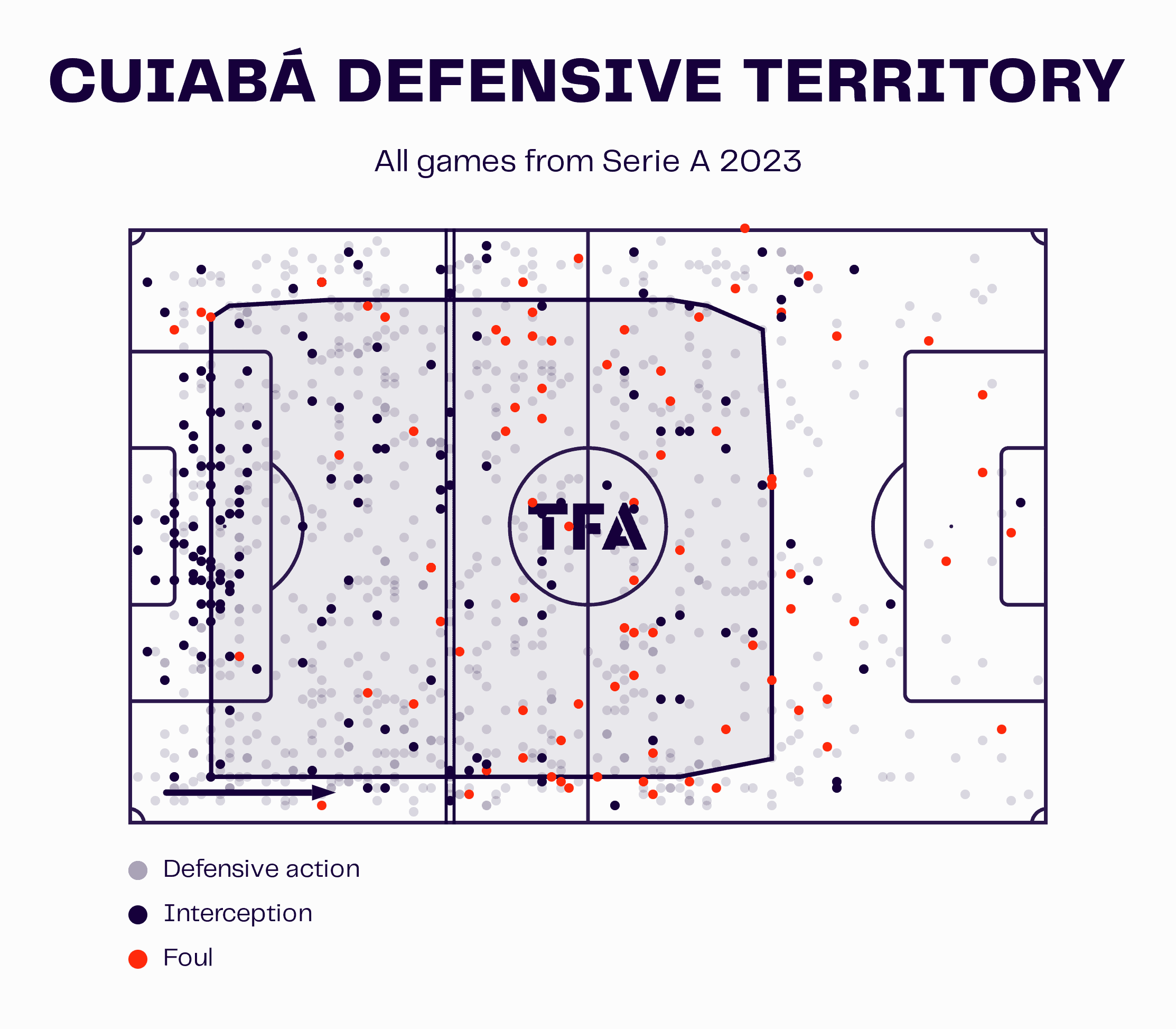
Cuiabá’s defensive territory map for the 2023/24 campaign is displayed in figure 5. One notable element of their defensive territory is how many interceptions occur inside their box. This is a result of the relatively passive defensive approach they take — don’t expect to see Oliveira’s side pressing very aggressively; they generally defend deeper, looking to drop off and prioritise occupying the critical spaces in front of their goal such as those heavily marked in navy on the map above.
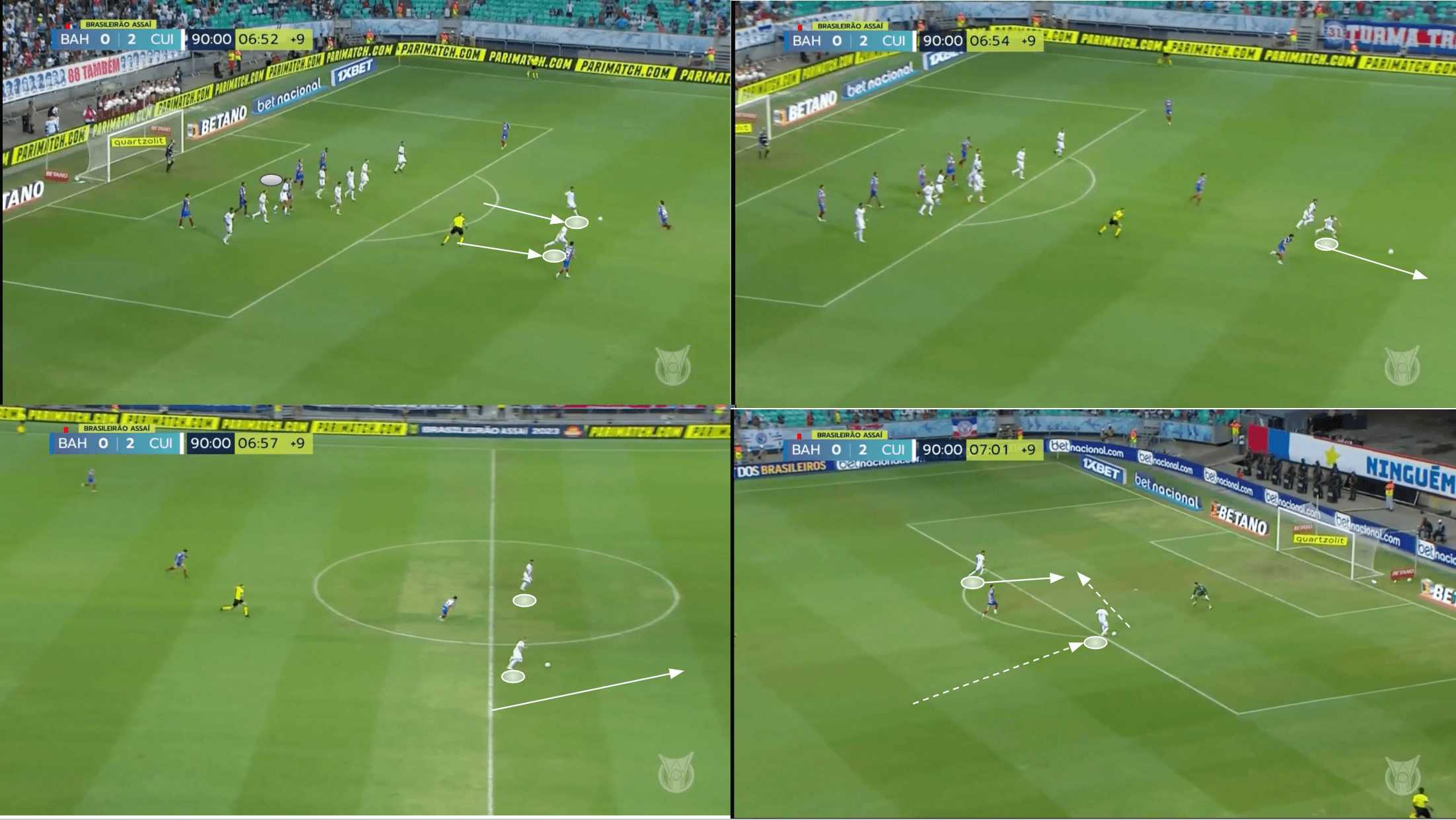
We see an example of Cuiabá in their low-block in figure 6. Here, Oliveira’s players have dropped off to cover the space in and around the goal mouth area. After the ball is cleared out of the box, it starts dropping towards an opposition player. However, Cuiabá’s forwards press aggressively to ensure it’s they who come out on top and regain possession, kickstarting a counterattack for their team.
The ball ends up being carried into a great position where Cuiabá essentially have a 2v1 against the opposition goalkeeper, enjoying a chance that it’d be criminal not to convert.
Along with the organisation and discipline in protecting their goal, this passage of play emphasises the importance of applying pressure on the second ball in Cuiabá’s defensive approach as well as counterattacks as it pertains to how Oliveira’s side create chances for themselves.
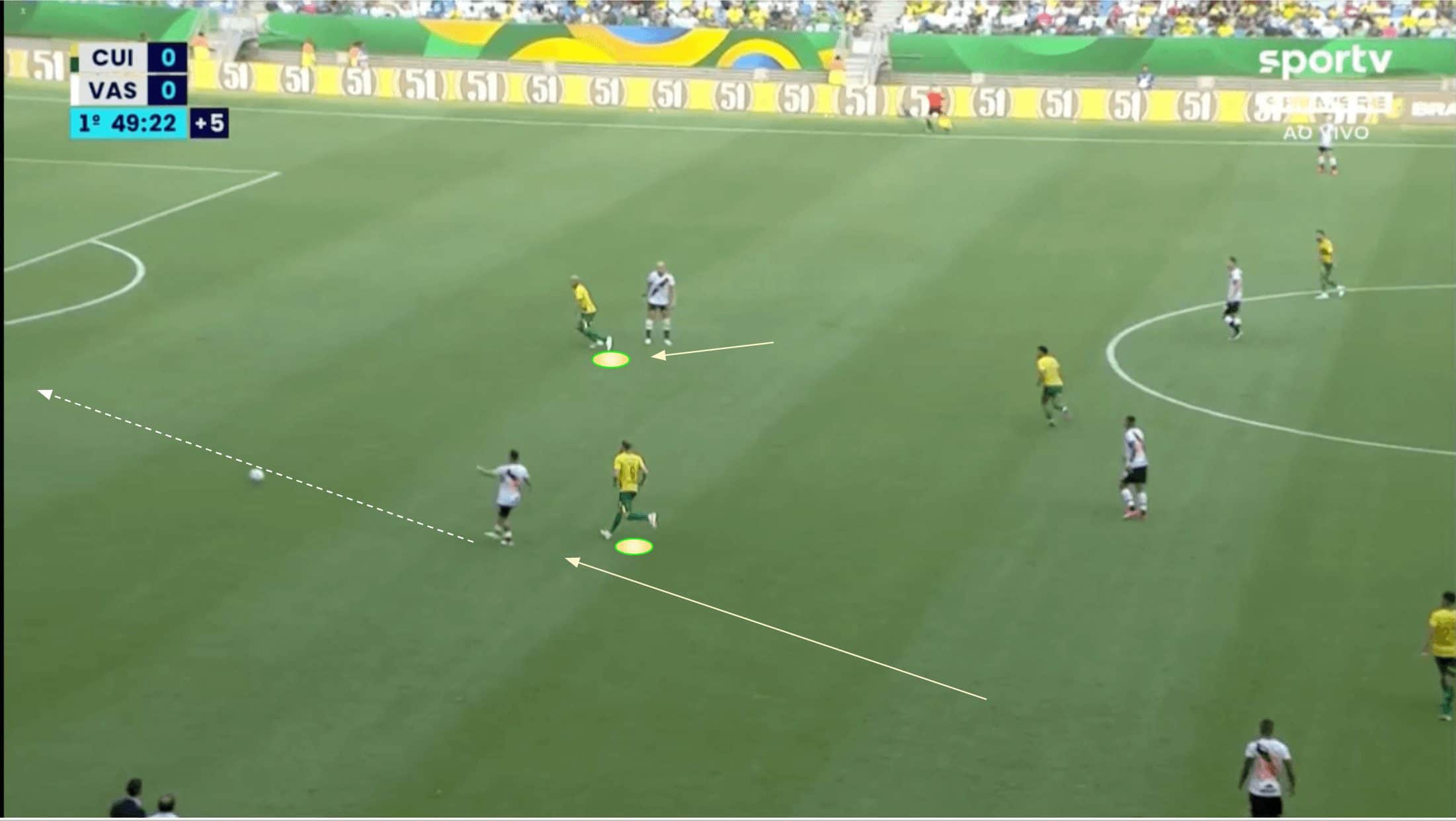
We see an example of how Oliveira’s side, in their typical 4-1-4-1 shape, stifled Vasco de Gama’s build-up and progression in their recent meeting here in figures 7 and 8. Firstly, as Vasco attempt to play out from the back, Cuiabá’s centre-forward cuts the pitch in half with the centre-forward marking the other centre-back while the centre-back on the ball is closed down by the left-winger.
This leads to the ball being played back from the right centre-back to the goalkeeper, who is then forced long.
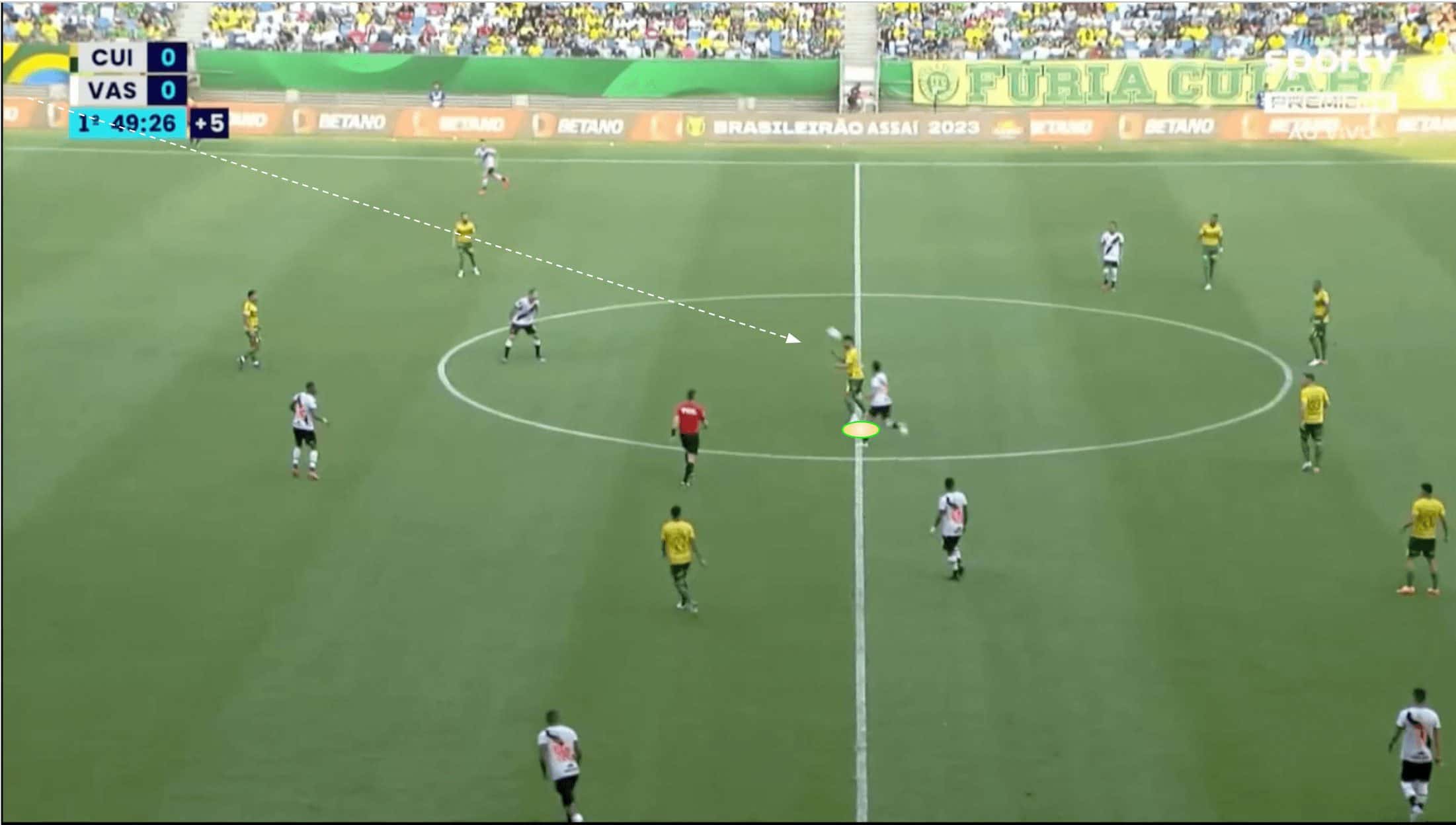
The ball drops into midfield, where a Cuiabá shirt is there to meet it, regaining possession for Oliveira’s side in the middle of the park, setting up a great opportunity to drive forward from here and attack in transition once more versus a relatively unprepared opposition backline.
Cuiabá’s possession play is quite limited as they spend the vast majority of their time playing without the ball. They defend fairly passively, in a position-oriented manner, prioritising organisation and protection of the space in front of their goal at all costs, and they aim to create as many opportunities to hit the opposition in transition as they can when it comes to goalscoring chances.
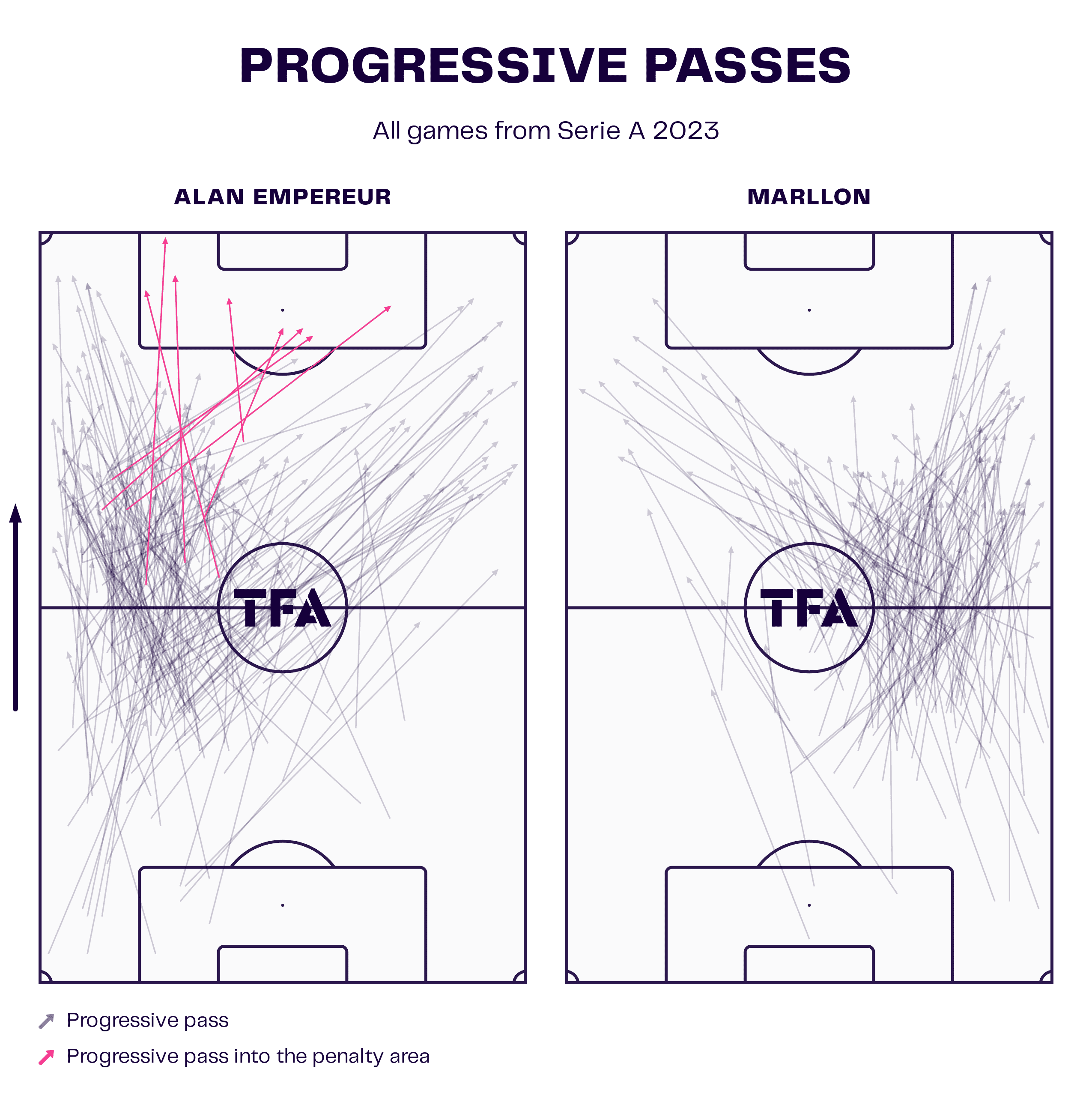
The centre-backs, typically Alan Empereur and Marllon, have essential roles in ball progression, both in settled possession and transition, frequently being tasked with springing passes in behind for attackers to chase down.
Both centre-backs are also often required to switch play from their side to the opposite side of the pitch as they try to take advantage of the space afforded to them and their teammates on the pitch in the best way possible during their attacks.
With a team of stronger quality, Oliveira may be able to show a different side to his coaching — and he may well welcome that chance. At the moment, what we can say for sure is he’s got a good ability to organise the team without the ball and exceed the sum of their parts as a unit with a low-possession, counterattack-heavy game plan, given the right level of commitment from the players at his disposal.
Patrick Kluivert, 47 years old, Adana Demirspor
Lastly, we’re going to have a look at legendary Netherlands forward Patrick Kluivert in his first senior club managerial role with Turkish Süper Lig side Adana Demirspor, where he’s been in charge for 18 games having taken over this past summer.
Adana currently sit third in the Turkish Süper Lig table, nine points off top. It’s not often that teams outside of Turkey’s big three — Fenerbahçe, Beşiktaş and Galatasaray — win the league, and we’re not suggesting Kluivert’s side will achieve that feat. However, they have enjoyed a very positive start to the 2023/24 campaign and have certainly put themselves in a position to be in all the right conversations regarding their division this term.
Primarily lining up in a 4-2-3-1 shape, Kluivert has led a highly possession-based side in Turkey this term, with Adana keeping an average of 54.6% possession this season — the fourth-highest in Turkey’s top flight. In addition, Adana scored the second-most goals in the league (23) and accumulated the third-highest xG in the league (18.77).
After some intricate passing plays at the beginning of the build-up designed to manipulate the opposition’s press and create viable passing lanes to enable Adana to progress through the thirds, Adana make it to the final third, where it’s common to see a lot of individual freedom afforded to players within certain guidelines.
Positionally, players will typically be fairly restricted within Kluivert’s system, but once they receive in the areas they’re supposed to be, hopefully with the intended time and space, they enjoy the individual freedom to drive at defenders, take them on 1v1 and create opportunities for their side. Adana have been a great side to watch for any football fan who loves dribblers this season, as the Dutch coach has succeeded mightily at creating plenty of favourable dribbling scenarios for his attackers via the structures they’ve implemented.
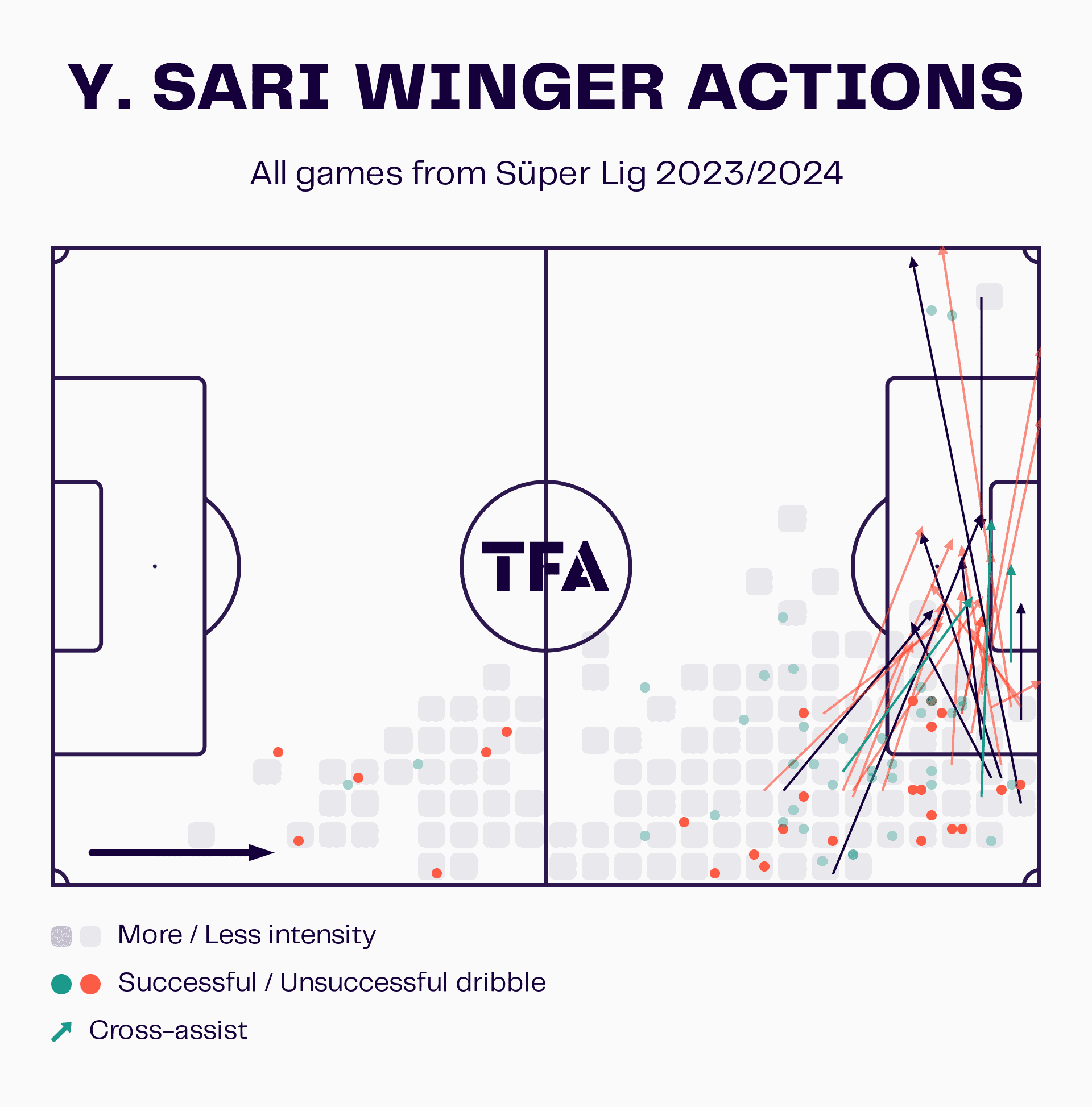
Yusuf Sarı, a 25-year-old senior Turkey international, has been a key dribbler and creator for this Adana side in 2023/24, with his ‘winger actions’ highlighted in figure 10. Here, we see the areas he’s typically occupied for his side marked out in the darker squares, dribbles colour-coded by successful/unsuccessful and crosses marked out by arrows.
Sarı has primarily operated from the right, where he’s frequently occupied the wide channel before carrying inside and taking a full-back on 1v1, as you might surmise from his heatmap and dribble locations.
He’s one player who’s certainly benefitted from being part of Kluivert’s system, which has successfully empowered the attackers by consistently placing them in favourable scenarios inside the final third.
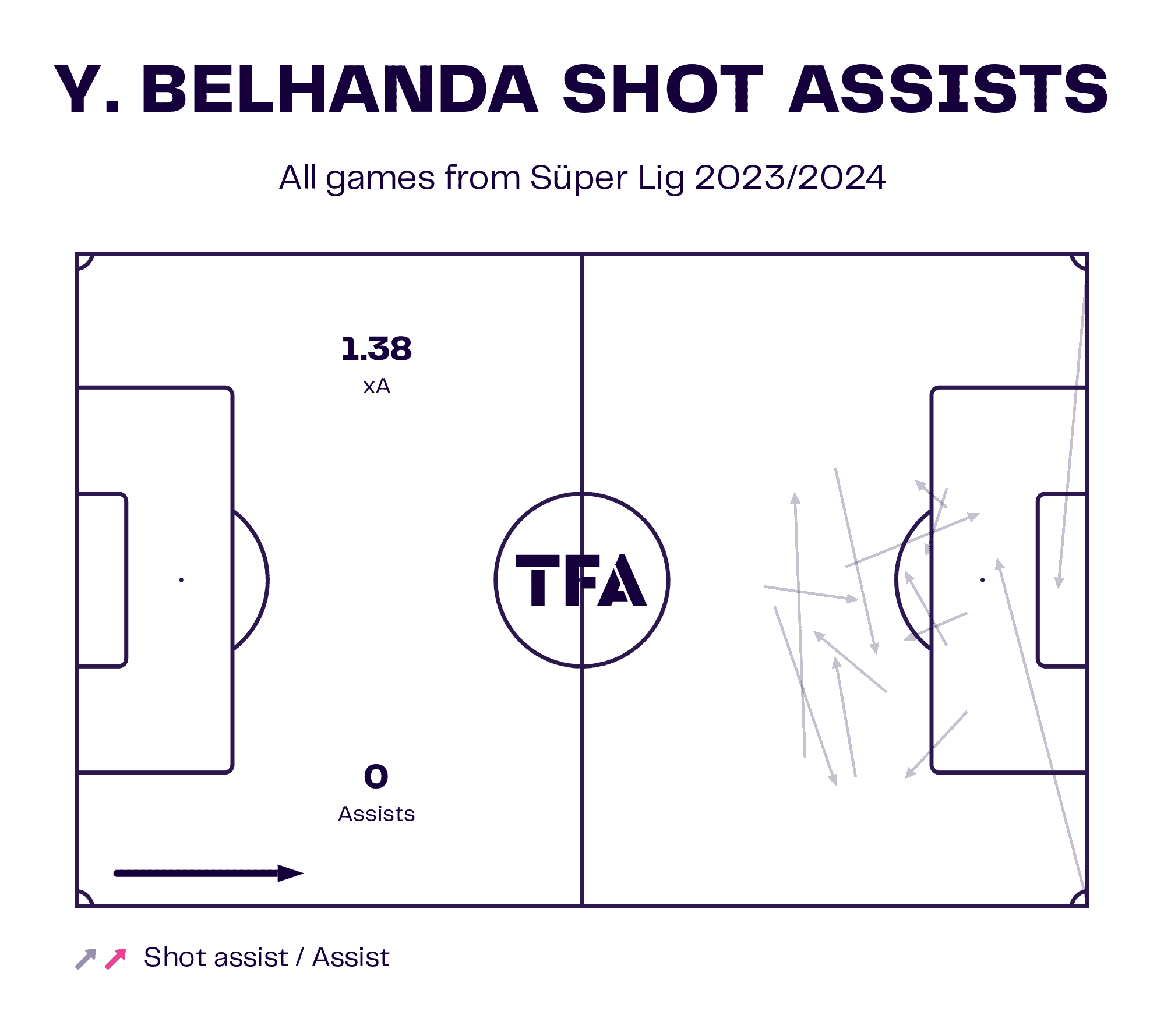
Younès Belhanda has operated as the ‘10’ within Kluivert’s 4-2-3-1. He’s also had a vital role to play for his side in terms of chance creation as well as his ability to find space in the final third, giving those positioned deeper a good passing option ahead of them to aim for and link the play from the progression phase to the chance creation phase.
Belhanda’s ability to free himself up, become a viable passing option, and link play in this manner has arguably been his greatest quality on display in 2023/24 — a quality Kluivert has endeavoured to make the most of within this team and their in-possession tactics.
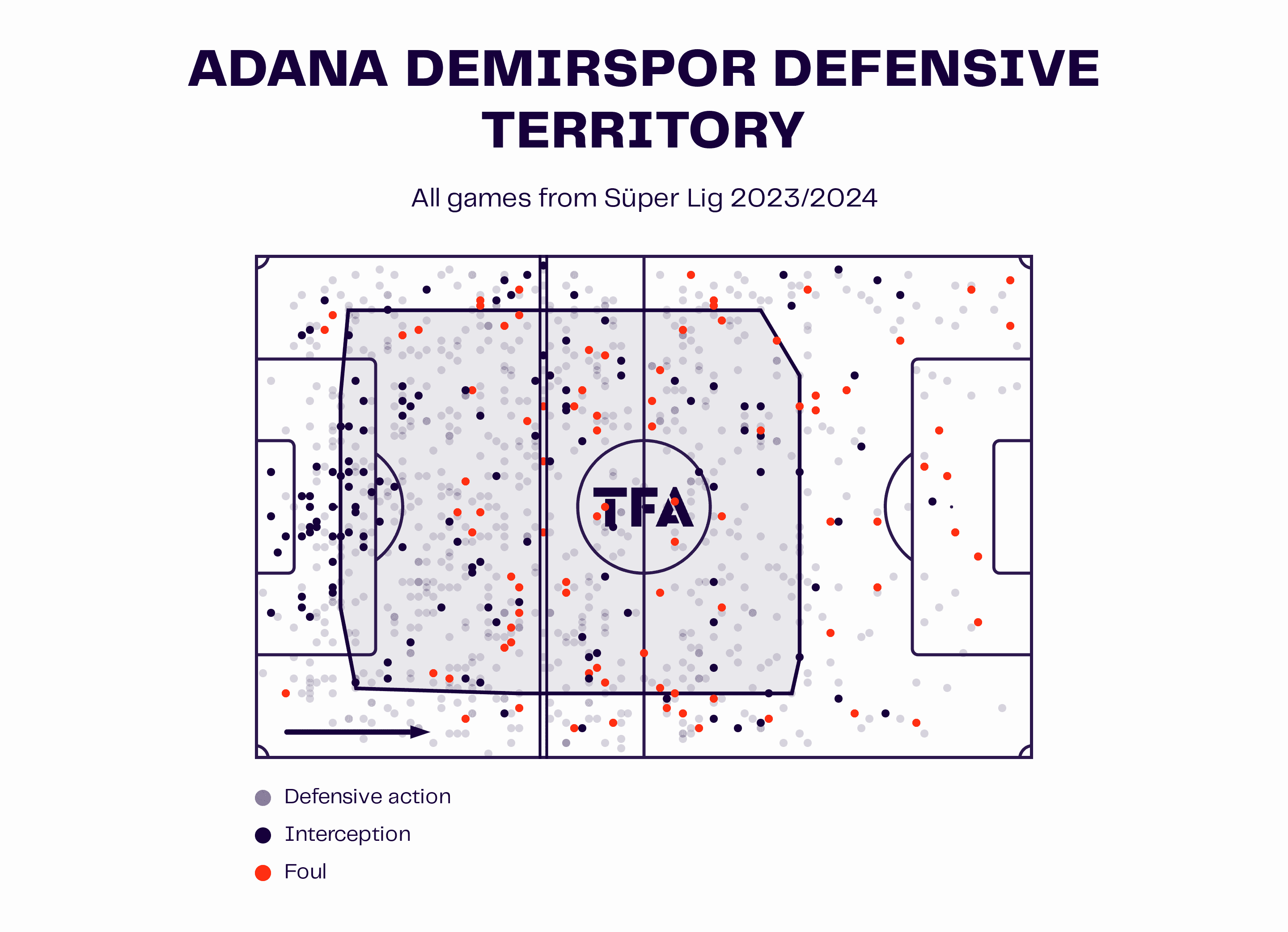
Adana’s defensive territory map is displayed in figure 12. Adana are not the most aggressive team in Turkey’s top-flight without the ball but do aim to regain the ball quickly and high upfield to force turnovers that can then generate good goalscoring opportunities. Their PPDA sits at 9.87 at present — the seventh-lowest in the Turkish Süper Lig.
Kluivert will likely aim to get the team defending even higher and forcing even more turnovers as time passes and he begins imparting his footprint more and more on the team.
During his time as Curaçao boss, Kluivert revolutionised the football played by the country, giving them a new identity inspired by the Cruyffian philosophy the Dutch coach is extremely familiar with both as a manager and as a player.
We’re now seeing the start of Adana’s transition into this type of team as well in very clearly identifiable ways that we’ve come to know and identify all too well, given how many clubs around the world idealise this type of football in the modern age, it’s only a matter of time before Kluivert is courted by a ‘Tier 1’ side wanting a change in this direction if he can keep up his current standard with Adana in Turkey.
Conclusion
To conclude this tactical analysis and manager-focused scout report, Javier Gandolfi, António Oliveira and Patrick Kluivert are three coaches to watch closely, with all being set for bigger and better things in the future given the level of quality they’ve shown in their current roles.
It won’t be long before ‘the next Rennes’ comes along, and a prestigious ‘Tier 1’ club is again managerless. Perhaps one of these three could be a worthwhile consideration in that case!





Comments